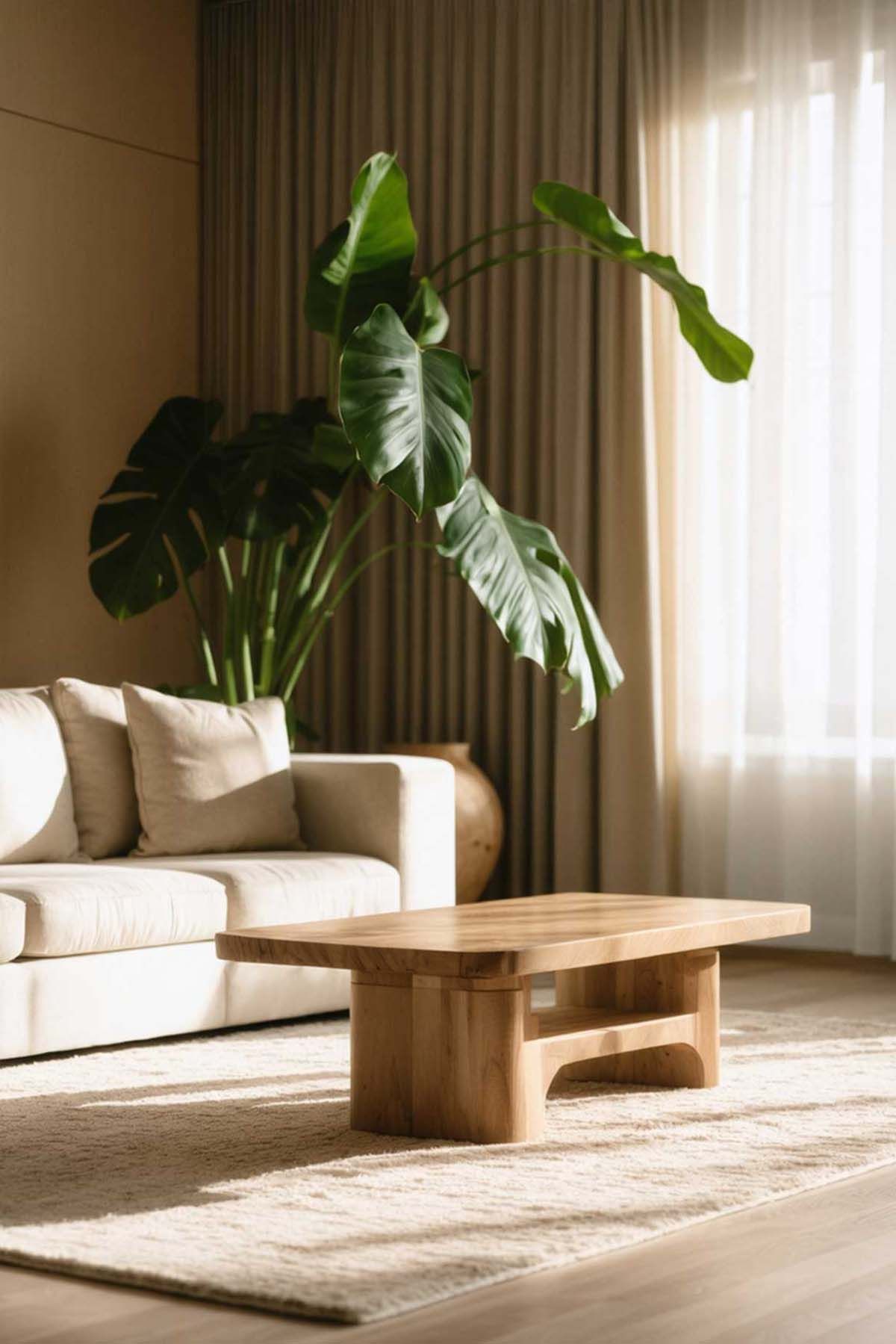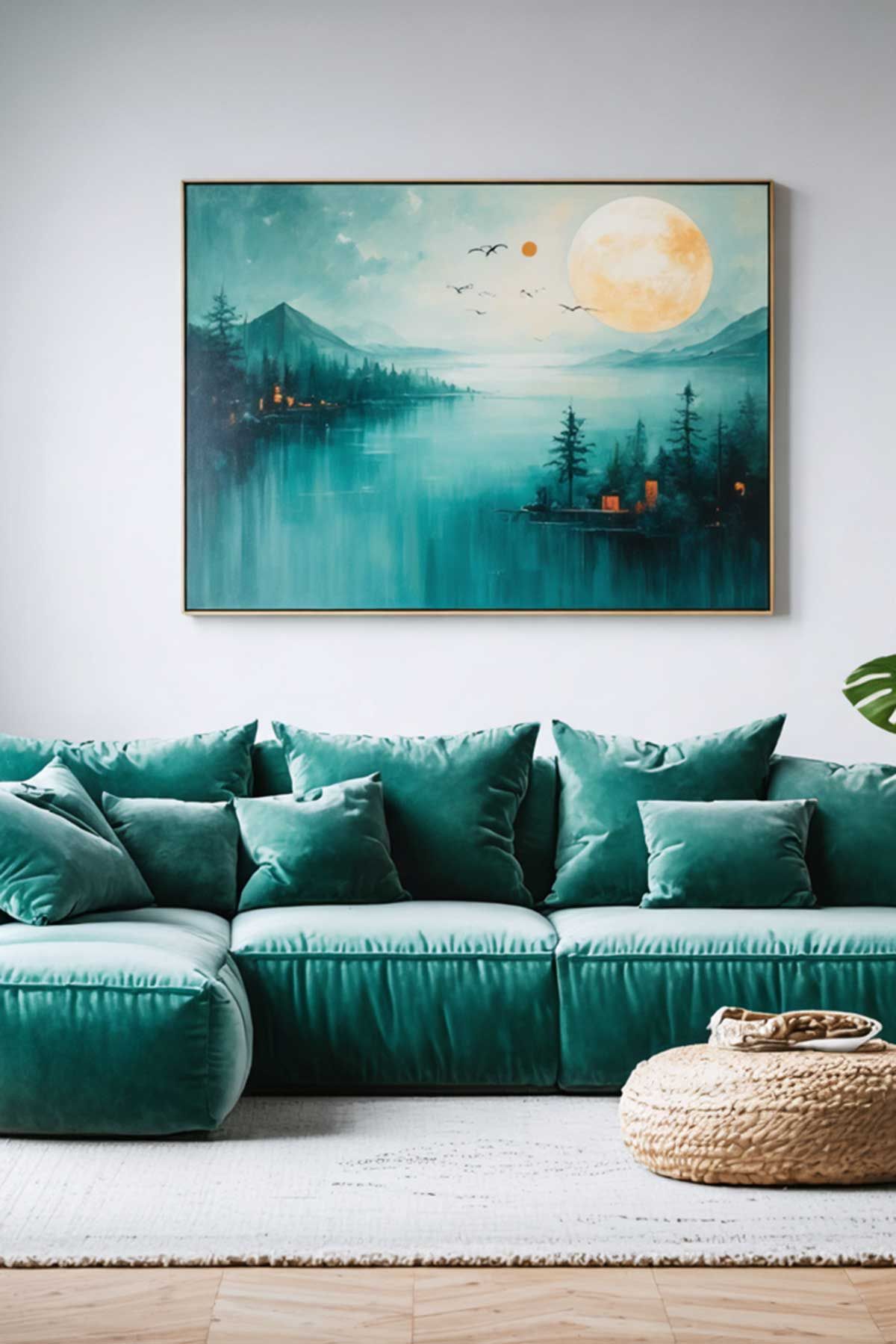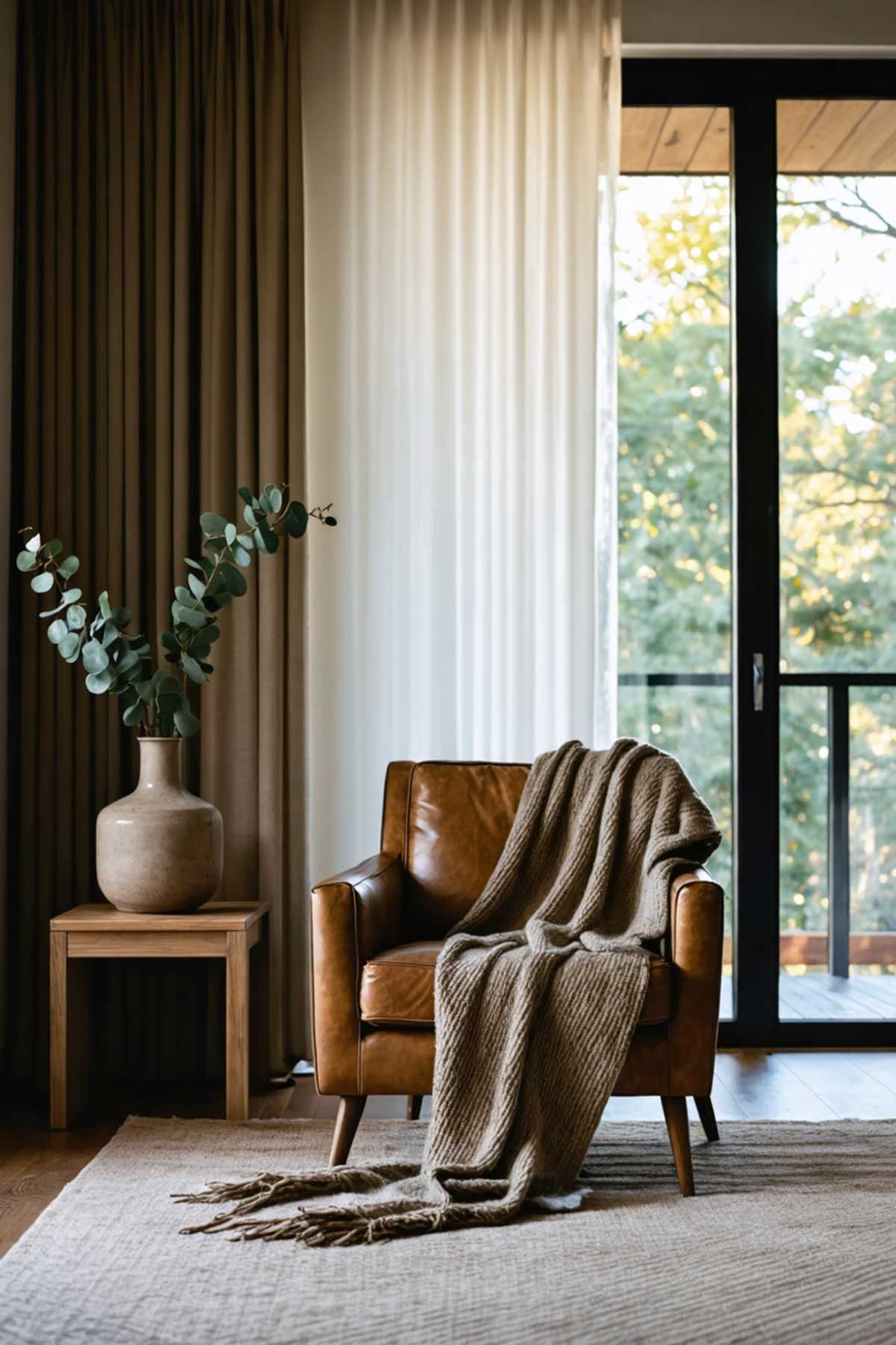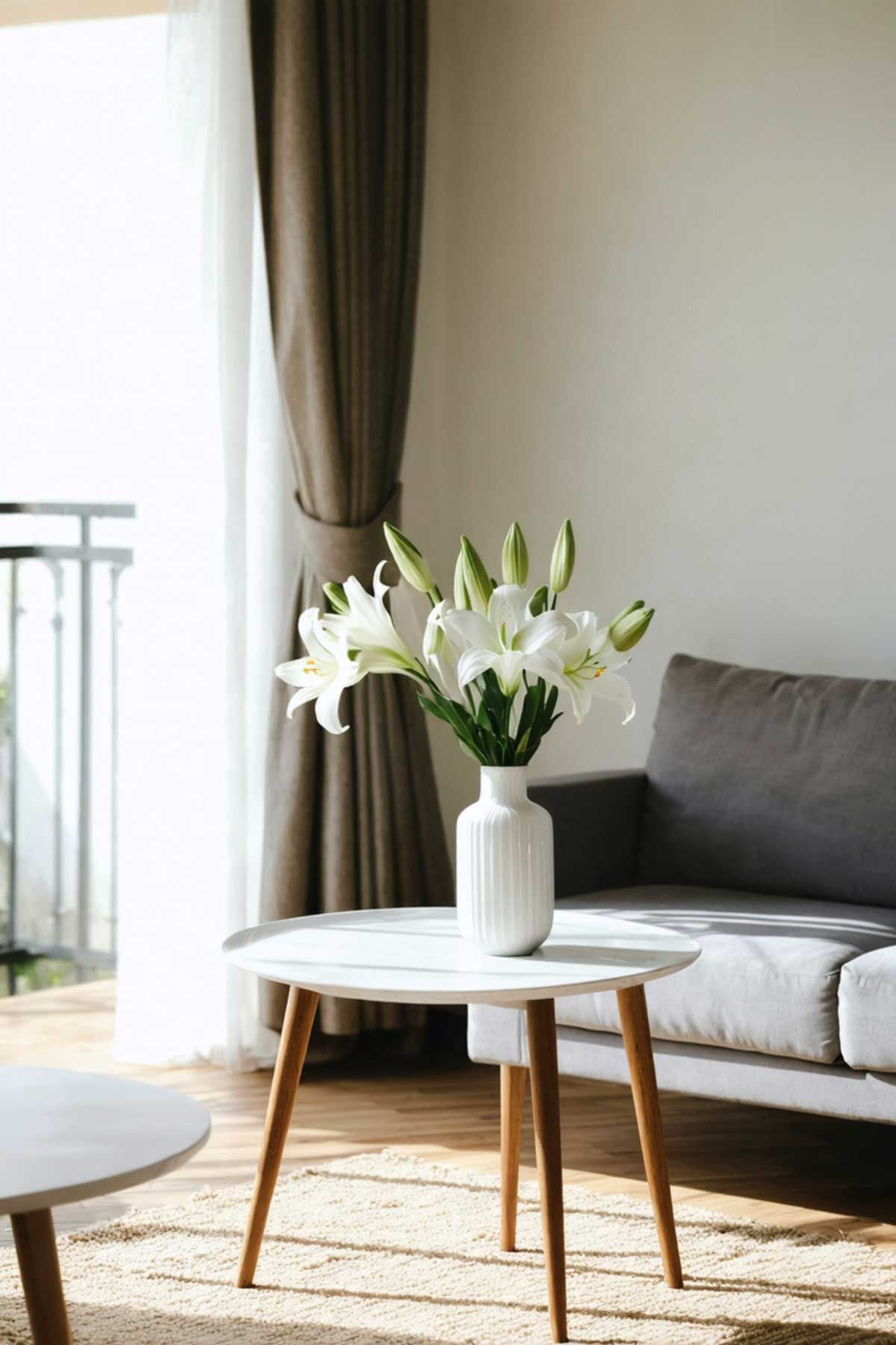How to Embrace the Less-Is-More Philosophy in Home Decor
Home Décor: The Less Is More Philosophy
In a world that pushes us to buy more, the “less is more” philosophy in home décor is a breath of fresh air. It teaches us to value mindfulness, function, and peace. As an Australian homeowner, you can break free from too much stuff and make a home that shows your style without being too busy.
The less is more philosophy in home décor teaches us to choose quality over quantity. It helps turn our homes into peaceful places where everything has a purpose. This not only makes our homes look better but also brings us peace, letting us enjoy our homes fully.

Having your soft furnishings in the same colour palate as the larger pieces does help to blend everything and create a more open and less cluttered look.
Understanding the Less-Is-More Philosophy
The “less is more” philosophy started in the 20th century. It was first seen in the work of architect Ludwig Mies van der Rohe. He wanted to move away from cluttered designs. Today, it’s a big trend in home décor, focusing on function, beauty, and feeling good.
Historical Roots of Minimalism
Minimalism began in the early 20th century. Architects and designers were tired of old, fancy styles. They started the modernist movement, which valued simplicity and clean lines. This led to the “less-is-more” style we know today.
Key Principles of Minimalism
- Functionalism: Minimalist design focuses on what works best, aiming for efficiency.
- Aesthetics: It highlights the beauty of simple shapes, letting the design speak for itself.
- Emotional Well-being: Minimalist design aims to create a calm, clutter-free space. It helps you feel more relaxed and focused.
Benefits of Adopting a Minimalist Lifestyle
- Reduced Stress and Increased Focus: Living simply helps you stay organized and focused. It boosts your productivity and mental health.
- Easier Maintenance: With fewer things, your home is easier to keep clean. You’ll have more time for other things.
- Sustainable Consumption: Minimalism encourages you to think before you buy. It helps the planet and saves resources.
- Timeless Aesthetic: Minimalist design looks good forever. It’s not tied to fleeting trends, so it always feels fresh.
By following the less-is-more philosophy, you can make your home calm, useful, and beautiful. It’s all about living simply and enjoying the basics.
| Minimalist Design Element | Benefit |
| Neutral Colour Palette | Creates a calm and unified look. It lets other design elements shine. |
| Decluttering and Organizing | Makes your space simpler and less stressful. It helps you focus better. |
| Multifunctional Furniture | Use space wisely and make your home more functional. |
Assessing Your Current Décor
Starting your minimalist home journey means first looking at your décor. Take a moment to check how your spaces work and if they’re cluttered. This step will show you where to simplify and achieve a cleaner look.
Evaluating Space and Functionality
Look at each room in your home carefully. Ask if you feel stressed or overwhelmed. Is the room easy to move around in, or is it too full?
Can you see other rooms clearly, or are there too many things blocking your view? Finding these issues is the first step to a better, more focused space.
Identifying Clutter and Unused Items
Then, find the clutter. This includes too much furniture, decorations, and stuff that takes up space. It also includes furniture that looks too similar, old decorations, busy patterns, and heavy curtains.
Knowing what clutter you have helps you decide what to keep and what to throw away. This is key to embracing the idea of less being more.
By checking your décor for functionality and clutter, you’re setting up your home for a calm, minimalist look. This step is important. It helps you make choices that fit your new, simpler style.
“Decluttering effectively may take a while, particularly if it’s not part of a regular housework routine.” – Interior Designer Tancred Vilucchi
As designer Tancred Vilucchi points out, getting rid of clutter takes time, even if you’re used to cleaning. But it’s worth it. A simpler, more organized space will make your life better.
Be aware though that this decorating style isn’t for everyone! I have a friend who has embraced it fully and loves how easy everything has gotten. She has large baskets and boxes for the kids toys and they know to put them back every time they use them. It works really well and she says she spends way less time cleaning because everything is so open and easy.
I have another friend who gets completely freaked out when she visits, because it feels sterile and impersonal to her, so its not for everyone.

Even in your kitchen, less is more doesn’t have to mean you have a completely clear bench top. Just less than what you might otherwise have works.
Choosing a Colour Palette
In a minimalist home, picking the right colours is key. A minimalist colour scheme with neutral tones makes a calm, timeless space. White, grey, beige, and black are great basics, letting décor pieces pop.
While neutral colours are popular, bold colours can add excitement. Knowing how colour affects space is important for an open feel.
Be aware though that minimalist décor DOES NOT HAVE TO MEAN BEIGE! Bright colours and textured fabrics work as well as anything else so don’t feel you have to have everything in tones of cream.
Neutral Tones vs. Bold Accents
Neutral tones offer a calm, unified look for your minimalist décor. A neutral palette makes rooms feel bigger and more peaceful. But, bold colours can bring life and balance to your design.
- Neutral colours like white, grey, and beige create a tranquil, grounding atmosphere.
- Pops of colour, such as rich jewel tones or muted pastels, can provide visual interest and personality.
- Balance is key – avoid overwhelming the space with too many bold hues.
How Colour Influences Perception of Space
The colours you pick can change how a room feels. Lighter, cooler tones make spaces feel open and airy. Warmer, darker shades can make rooms cozy and intimate.
| Colour Effect | Perception of Space |
| Warm Colours (Reds, Oranges, Yellows) | Cozy, Intimate |
| Cool Colours (Blues, Greens, Purples) | Open, Airy |
By choosing a minimalist colour scheme wisely, you can make a beautiful, harmonious minimalist home.
Selecting Essential Furniture Pieces
When designing a minimalist interior, focus on function over form. Choose furniture with clean lines and simple designs. These pieces should be both beautiful and practical, without unnecessary decorations.
Prioritizing Function Over Form
In a minimalist space, each piece of furniture should have a clear role. Use furniture with sleek metal frames or items that seem to float. This creates a sense of openness and follows minimalist principles.
Choose furniture with hidden storage to keep your space tidy. This helps reduce clutter and makes the most of your space.
Multi-Functional Furniture Options
- Coffee tables with built-in storage compartments
- Sofa beds that double as comfortable seating and sleeping areas
- Ottomans with concealed storage for blankets, magazines, or other household items
- Modular shelving systems that can be customized to fit your specific needs
By picking furniture that does more than one thing, you can make a minimalist home that looks great and works well. This way, you not only cut down on clutter but also use your space better.
| Furniture Type | Functionality | Minimalist Attributes |
| Floating Shelves | Display décor, store books, and organize items | Sleek, wall-mounted design that creates an illusion of openness |
| Convertible Sofa Bed | Comfortable seating and sleeping option in one piece | Clean lines, hidden storage compartments, and versatile design |
| Storage Ottoman | Concealed storage for blankets, magazines, and other household items | Minimalist upholstery, simple silhouette, and multi-purpose functionality |
The secret to picking functional furniture for a minimalist home is to focus on pieces with a clear purpose. They should also keep your space clean and uncluttered. By choosing high-quality, multi-functional items, you can create a space that is both beautiful and efficient.

A minimalist living space with a vibrant ocean coloured sofa.
Mindful Décor and Accessories
When you’re into minimalist décor, picking your home’s accessories and décor is key. The idea is to choose a few, but meaningful, pieces. These should make your space look good and work well.
Choosing Quality Over Quantity
Don’t buy lots of decorative items. Go for a few, high-quality pieces that mean something to you. A HomeGoods survey showed 40% like minimalist décor for its calm and simplicity.
The Power of Statement Pieces
Instead of filling your space with lots of small items, pick a few statement pieces. These could be eye-catching artworks, sculptural vases, or unique lights. A 2023 Houzz survey found 60% of homeowners love minimalist interiors for their clean look.
By picking quality over quantity and using statement pieces, you can make a beautiful, calm minimalist space. It will show off your style and bring peace to your home.
“Mindful minimalism in interior design emphasizes precise geometry and uncluttered spaces.”
Embracing Natural Light
Using natural light is key in minimalist home décor. It makes rooms look bigger and more welcoming. Big windows or sheer curtains help bring in more light, changing the room’s feel all day.
Benefits of Natural Light in Home Decor
Natural light goes well with minimalist colours, highlighting furniture and décor. It makes spaces feel airy and calm, perfect for a minimalist vibe. Studies also show it boosts mental health, reducing stress.
Tips for Maximizing Light in Spaces
- Install large windows or skylights to allow maximum natural light to enter the room.
- Use sheer curtains or opt for window treatments that don’t obstruct the flow of light.
- Position mirrors strategically to reflect and amplify natural light throughout the space.
- Incorporate lighter-coloured walls and furnishings to create a bright, airy atmosphere.
- Strategically place lighting fixtures to complement the natural light and create a cohesive, minimalist aesthetic.
By embracing natural light, your minimalist home décor becomes more inviting. The way light and shadow play can really change how your space feels.
A serene room bathed in soft, natural light streaming through large windows, highlighting minimalistic furniture and earthy décor elements, gentle shadows dancing on wooden floors, lush green plants in the corners, a sense of tranquility and openness.
Window treatments can still be curtains, but use a full length option to elongate the window and enforce the open space. Somehow longer floor length curtains can still appear minimalist if the colour isn’t too obtrusive. I tried some on our front window and strangely the full block out curtains actually made the space appear cleaner than the mesh curtains did.
Organizing for Minimalism
Starting a minimalist home décor style needs a smart plan. You must declutter well and pick storage that fits your space. This makes your home tidy and peaceful.
Strategies for Decluttering
Start with one room at a time. Try the “15 minutes a day” method for steady progress. When sorting items, think about their use, value, and need.
Use the Swedish Death Cleaning method. It helps you see how items will be seen later.
- Sort items into donate, sell, recycle, and keep piles for easy sorting.
- Try the Penalty Box strategy for unsure items. It lets you think before deciding.
- Get help from professional organizers. They offer tailored advice and support.
Storage Solutions that Blend In
After decluttering, focus on storage that fits your minimalist style. Choose built-in cabinets, shelves, and drawers. They save space and keep your home tidy.
Use furniture that does more than one thing. For example, ottomans with hidden storage. They hide items without ruining your space’s look.
| Minimalist Organization Tip | Benefit |
| Use vertical storage to save floor space | Creates a neat and attractive space |
| Label storage containers for easy identification | Reduces time finding items and keeps your space clean |
| Designate a specific place for every item | Prevents clutter on surfaces |
By following these tips, you can make a calm, clutter-free home. It shows your love for simplicity and usefulness.
Creating a Personal Aesthetic
Embracing minimalism doesn’t mean you have to give up your personal style. It’s actually a chance to make a space that truly shows who you are. By carefully picking your home décor, you can mix the simplicity of minimalism with things that show your unique taste.
Reflecting Your Style through Minimalism
The secret to a personalized minimalist look is to choose quality over quantity. Pick a few high-quality, versatile items that match your style. This could be a standout piece of art, a classic piece of furniture, or a special accessory. These chosen items will shape the look and feel of your space.
Incorporating Cultural Elements
Adding cultural touches to your minimalist design can make your home more interesting and personal. Personalized minimalism means adding meaningful cultural items, textiles, or art that are important to you. These touches will show your unique background and make your home feel welcoming and rich in heritage.
Remember, minimalism’s beauty is in highlighting what’s most important to you. By carefully choosing your home décor and adding personal and cultural elements, you can make a space that’s both beautiful and a true reflection of your cultural minimalism.
“Minimalism is not a lack of something. It’s simply the perfect amount of something.” – Nicholas Burroughs

Having your soft furnishings in the same colour palate as the larger pieces does help to blend everything and create a more open and less cluttered look.
The Role of Textures in Minimalism
In minimalist design, textures add depth and interest without clutter. By mixing different textures, you can make a space visually appealing. This makes your minimalist space look better.
Layering Textures for Depth
Textural contrast brings life to minimalist spaces. Mix soft and hard textures for depth. Soft fabrics like wool or velvet pair well with metal, wood, or stone.
This mix adds warmth and intrigue. It prevents your space from feeling too simple or empty.
Soft vs. Hard Textures
Soft and hard textures balance each other in minimalist décor. Soft items, like throw blankets, soften hard surfaces like wooden tables. This balance makes your space feel cozy and inviting.
| Soft Textures | Hard Textures |
| Wool, Linen, Velvet, Sheepskin | Wood, Metal, Stone, Concrete |
| Plush, Cozy, Organic | Sleek, Rigid, Industrial |
| Add Warmth and Comfort | Provide Structure and Contrast |
By carefully mixing minimalist textures and textural contrasts , you can make a peaceful yet engaging space. It’s a perfect blend of simplicity and depth.
A serene minimalist interior featuring a soft, neutral colour palette, highlighting an array of textures such as smooth stone surfaces, woven linen fabrics, matte wood finishes, and sleek glass elements. The composition should evoke a sense of calm and simplicity, with natural light softly illuminating the different textures, creating subtle shadows and depth.
Maintaining a Less-Is-More Home
Keeping a minimalist home clean and clutter-free takes effort and attention. Start by setting up a regular cleaning routine. This helps keep your space tidy. Also, use seasonal purging strategies to get rid of items that don’t bring joy or serve a purpose. This way, your home stays peaceful and organized all year.
Establishing a Cleaning Routine
Make cleaning a part of your weekly routine. Set aside time each week to clean and organize. This keeps clutter away and keeps your home calm.
Seasonal Purging Strategies
- Review your belongings twice a year, with the seasons.
- Check each item’s usefulness and if it fits your minimalist lifestyle.
- Give away, recycle, or throw away items that don’t bring joy or serve a purpose.
- Change out seasonal clothes, décor, and accessories to keep your space tidy and looking good.
By sticking to a minimalist maintenance routine and doing seasonal decluttering , you can keep your home peaceful and organized. It’s easy to maintain the calm, functional space you’ve created.
“The ability to simplify means to eliminate the unnecessary so that the necessary may speak.” – Hans Hofmann
Conclusion: Your Journey to a Simplified Space
Your path to embracing minimalism in home décor is a journey of growth and discovery. Minimalism is not a one-size-fits-all idea. It’s a personal way of living that changes as you do. Keep exploring and learning to make a space that truly feels like you.
Final Thoughts on Minimalist Living
Minimalist living isn’t about being deprived or having a bare space. It’s about making choices that reflect your values and what’s important to you. Enjoy the process of decluttering and focusing on quality over quantity. Remember, minimalism is a journey, not a final goal. Be patient with yourself as you find your way.
Resources for Further Inspiration
Start your minimalist journey by checking out many resources. Read blogs, books on decluttering and living sustainably. Connect with others who share your interests. A community of minimalists can offer the support and motivation you need to create your dream space.
Accounts and People To Follow
These are just a few of the social media and blogs I follow that you might like.
- hygge_by_kate on Instagram. Her designs are beautifully soft without being stark.
- daniellawitte who is a Holistic Therapist but has a beautiful less-is-more styled home that is still very warm and welcoming
- minimaliststyle a larger account that features amazing images.
Some Houzz articles that showcase how to use the less-is-more principle and not have a stark white house!

A simple side table with lilies in a minimalist living space.
FAQ: How To Embrace Less-Is-More In Your Home
What is the “Less is Best” approach to home décorating?
The “Less is Best” approach means choosing what’s truly important in your home. It’s about getting rid of clutter and focusing on what makes your space calm and welcoming. This way, your home reflects your style without feeling too busy.
What are the key principles of minimalism?
Minimalism is about function, beauty, and feeling good. It started in the 20th century with designers wanting to get rid of fancy designs. They wanted something simpler and more modern.
What are the benefits of adopting a minimalist lifestyle?
Minimalism makes your home feel calm and easy to take care of. It’s also simpler to keep clean and organized. Plus, it’s a way of life that values simplicity and being mindful of what you buy.
How do I assess my current décor for minimalism?
First, check if your space is functional and free of clutter. If you feel stressed or see too much stuff, it’s time to simplify. Look for signs like feeling anxious or seeing too much clutter.
How do I choose a colour palette for a minimalist home?
Pick a neutral colour scheme for walls, floors, and big furniture. This creates a calm background for your home. Use whites, grays, beiges, and blacks as a base. Then, add bold colours to make your space interesting.
What should I consider when selecting furniture for a minimalist space?
Choose furniture that’s both useful and looks good. Go for pieces with simple designs that serve a purpose. Avoid too much décoration and look for furniture with hidden storage to save space.
How should I approach décor and accessories in a minimalist home?
Be careful with décor and accessories. Choose a few high-quality items instead of many cheap ones. Pick meaningful art or sculptures to add interest without cluttering your space.
How can I maximize the use of natural light in a minimalist home?
Natural light makes your home feel bigger and more welcoming. Use big windows or sheer curtains to let in more light. This also fits well with the minimalist colour scheme.
What are some strategies for organizing and maintaining a minimalist home?
Keeping your home organized is key to minimalism. Start by decluttering a little each day. Make sure everything has a place and choose storage that looks good. Regularly go through your belongings to keep your space simple.
How can I create a personal aesthetic within a minimalist home?
Even with minimalism, you can still show your personality. Choose items that are meaningful to you, but don’t overdo it. This way, your home feels like yours, but still simple and elegant.

About The Author
I'm Channing and I am the driving force behind Platypus and Pine. I've had over 30 years of experience in designing, renovating and customising Australian homes.
I've used everything from aluminium to velvet as decor choices and love a wide variety of styles and themes.
My absolute favourite is Mid Century Modern and I was fortunate enough to spend 2 weeks in Palm Springs for Modernism week just last year.
